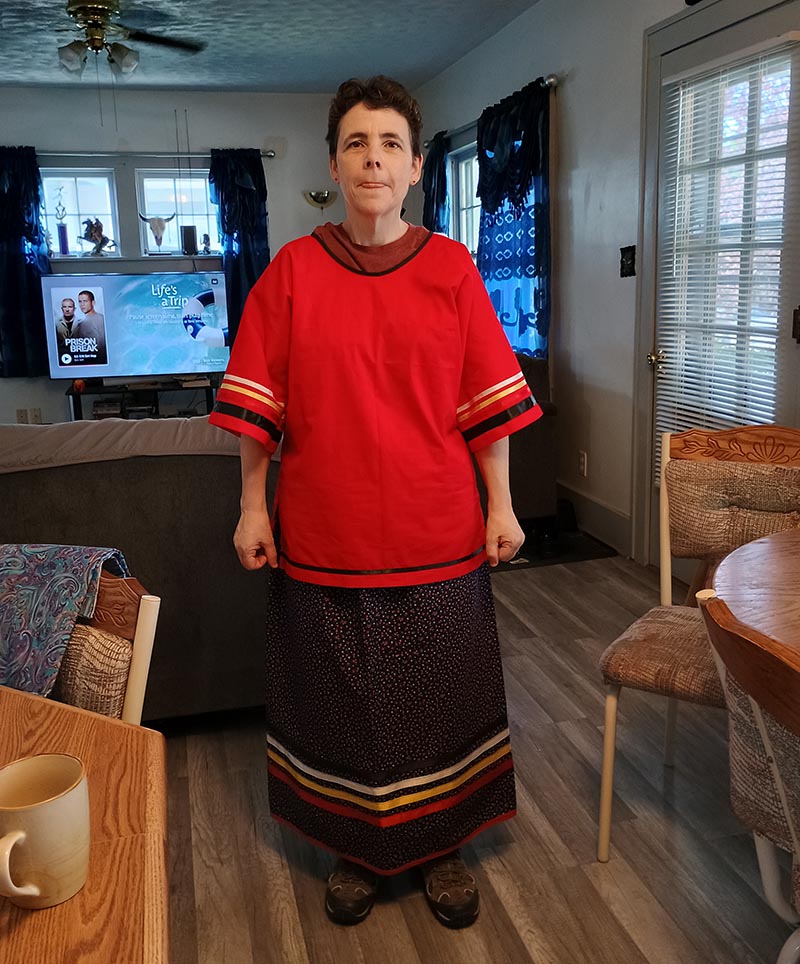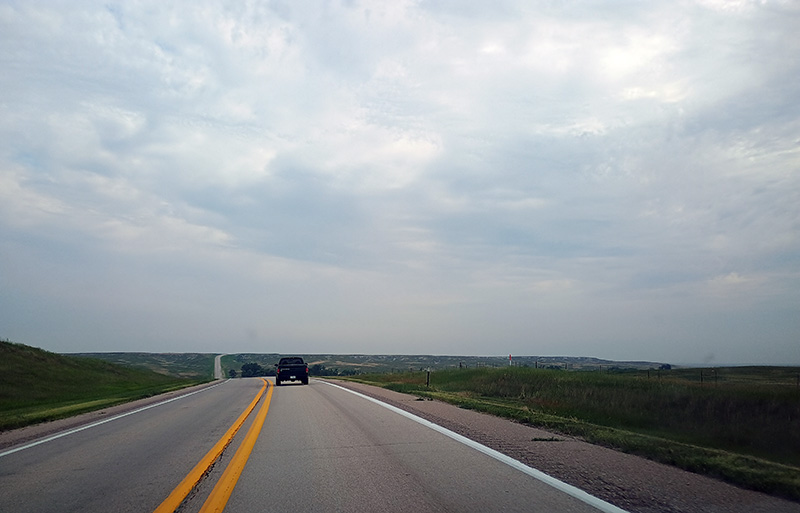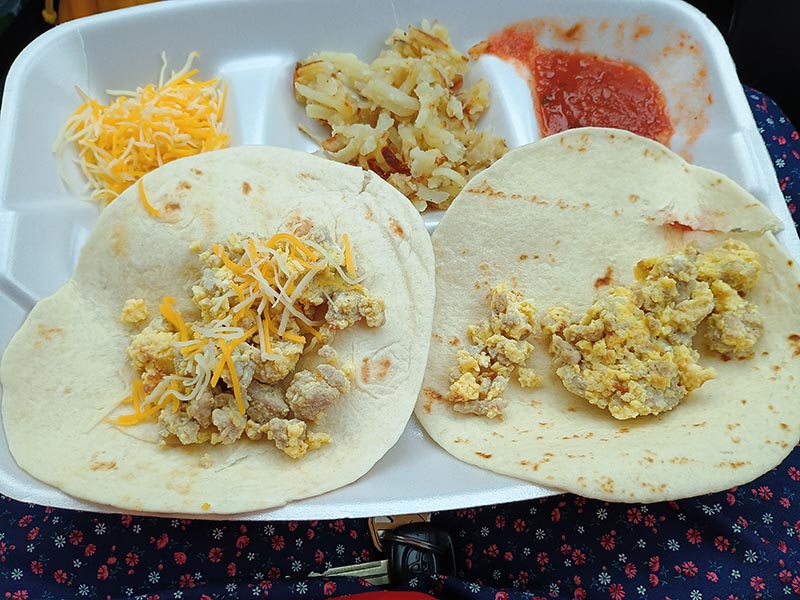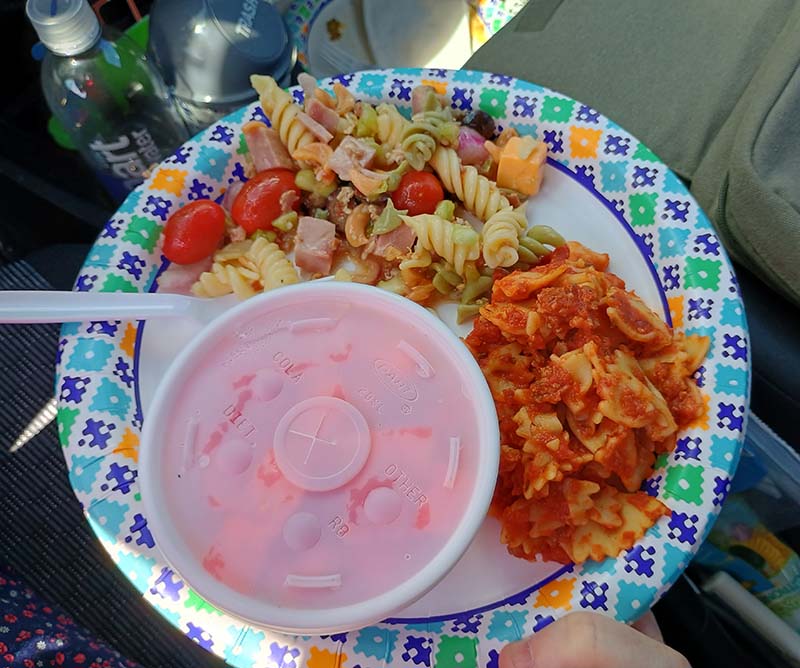Driving East out of Scottsbluff, I pass all the familiar sights which bring me peace and put a smile on my face. There were the dozen or so horses walking with each other in still dew-laden field. Red cows meandered among the shimmering rolling hills of the morning. The sun glistened everything along my route North along Highway 385.
Somewhere past Alliance and before Chadron I turned right down a dirt road. Around a quarter of a mile later, I turned left into a field. I had reached my destination of a journey that had begun more than a year before.
*****
I was talking with Edison Red Nest at the powwow held in the shadow of the Scotts Bluff National Monument about a variety of topics. At some point, he asked me, “would you like to go to a Sun Dance?”
“Yes, of course I would, but I always assumed I never could,” I said. I knew a little bit about the history of the Sun Dance (Wiwáŋyaŋg Wačípi) and how it was banned for so long by the U.S. Government. They were afraid of what would happen if American Indians were allowed to continue to practice their culture. Attending a Sun Dance was never on my radar because it is a highly personal ceremony and I am white and an outsider.
“Let me see what I can do,” he said. “But if you go, no cameras.”
He pointed at my Canon EOS R7. I always have a camera with me. Cameras have been with me since I got my first Kodak Hawkeye Instamatic 110 camera in the early 1980s. I didn’t hesitate in my reply.
“Okay, not a problem. No camera.”
He wasn’t able to get permission for 2024, but he did for 2025. His wife, Jina Red Nest, who has been a friend of mine for more than a decade, made me an outfit. Women must wear skirts at the Sun Dance. Knowing me well, Jina made the waist large enough to accommodate my shorts underneath.
On July 11, I met Edison at 8 a.m. I followed behind him to Alliance, where he picked up his grandson and then we continued toward the site of the Sun Dance. As I turned into the pasture, there was a worn wooden sign that read “no booze, no drugs” on the left side and “women with the moon are not allowed to enter” on the right.
It was day three of the four-day ceremony for the men and women participating. I parked my car next to Edison’s truck. He reminded me not to take my pen, notepad, phone, and everything else with me into the arbor. “Only take yourself with you,” he said.
I pulled my folding chair out of the trunk and walked under the newly built arbor where family and invited guests could sit. It was a cool morning. The temperature was supposed to get up to a high of 80. As I sat and waited for the next part of the ceremony to begin, I noticed the smell of sage everywhere. A young man around seven years old carried a tin bucket of burning sage around for smudging to everyone for personal use. I watched what everyone else did and repeated the same steps. I would do this dozens of times over the next two days. I would also be provided the opportunity four times to share in smoking sage from a pipe.
*****
Sun Dance means “Dancing in the Circle of Light.” A large tree, known as the “Tree of Life” is placed in the center of a circular arbor. The arbor is made of 28 tree poles, which align to the rising sun. The sacred tree stood in the middle of the circle. It had been cut down before the Sun Dance began and never touched the ground again until it was placed within the circle. Each piece of cloth tied to the tree is a prayer. It is said the sage smoke carries the prayers to the sky where they will be heard. The arbor encircled the smaller circle where the participants danced and sang around the sacred tree.
Participants were on the North side of the arbor. Their tents with muted colors, most likely faded with the sun stood next to the dancer’s lodge. The colors of the Lakota – black, yellow, white, and red – were everywhere.
I was momentarily distracted by the young man carrying the sage. You cannot cross the eastern border opening of the circle. So, he would walk to the opening of the circle on the East, turn around, and walk all the way around to the opening on the other side. Along the way, he offered every person he passed smudgings. Exposing yourself to the smoke, it is said, cleanses negative energy. As long as there were dancers in the circle, the young man was walking back and forth. He must have walked miles each day fulfilling his role in the Sun Dance. Not once did he waver in his task or ask to be relieved of it.
A young man on the other side of arbor caught my eye. He was tending to the fire that kept burning the entire time I was there. From a distance, he looked like Geoffrey, a young man my husband and I once mentored. Geoffrey has been gone seven years. It wasn’t him, but this young man’s mannerisms and gait were so similar, it made me think of Geoffrey and how I wished he was still alive.
A dance lasts as long as a dance lasts, I was told. The dancers decide how long the break in between the dances will be. They are fasting for four days and sometimes need a little extra rest before the next round. Fasting brings you closer to the spirit world. In their culture, some will tell you the dancing brings you as close as you will ever be to the creator.
Male dancers were clad in a red skirt. Most were badly sunburned by the time I arrived on Friday morning. Female dancers wear long skirts adorned in spectacular designs of their choosing. Most choose the colors of the Lakota and shine in the sun. Their arms are exposed to the rays of the sun. All dancers wear rings of sage on their heads and around their wrists and ankles. Each man carried a whistle made from the wing bone of an eagle. The sound echoed throughout the arbor as they blew into it in rhythm with the drummers.
*****
In this little valley, there is no cell service. It makes no difference to me. The wind blows as it does on the Great Plains, making the tents come alive as they sway back and forth in the late afternoon breeze. A hawk flies overhead. I watch it as it seems to be playing in the currents in the air. The music of the drums fill my heart with joy.
All of the songs I hear are prayers. The dancers pray west, north, east, and south in each round. The cadence of the drums and voices of the singers exude a reverence felt within. I do not speak Lakota, but I recognize the difference in the songs here from the ones at a powwow. There is a tonal difference and the words feel more meaningful here.
*****
During the Sun Dance, there is a piercing round. Men are pierced, usually on their back and women make a flesh offering on their forearm. When the men are pierced, they become one with the tree via the wooden skewers and a long line of rope. Prayers are sung while another man, who has also been pierced and attached to seven bison skulls, pulls the skulls around the circle four times. Any suffering is endured for the good of the community. Some men are lifted in the sky. Near the end of the prayer, they will each take a turn breaking free.
When I asked what the breaking free means or symbolizes, I was told, “when you enter the circle, all you have to give is yourself.” The dancers endure any suffering or pain for the good of their community. They honor what the sun has given them and they give a piece of themselves to something greater than themselves. It is to help the entire community in whatever struggles they might have and to heal.
Everything is done in fours. Dancers make a four-year commitment to the Sun Dance. There are four seasons, four directions, four songs, four rounds of dancing, four days of fasting, and four days of Sun Dance.
*****
As we waited for the next round of dances, one of the drummers spoke. He encouraged us to take the time to reflect and think about those who are not here or those who are suffering. I thought about my mom and how I wish she was here, but also that she is not suffering anymore. I thought about my grandma. I still miss her every day. I no longer have her wisdom other than what she taught me before she was gone. And I thought of Geoffrey and how I wished he found peace before he left us.
I also thought of myself. I keep a lot of my suffering inside. It only fully comes out on Fridays when I speak to my therapist. I’m not sure it would be a good thing to post here the 90% that I keep inside. I thought about how I want to move forward in my life. I thought about how to keep writing and how to make it through July, which has now become a month of suffering for me.
The day had grown cold. It was not as warm as predicted. At 7:20 p.m., it was 59 degrees. There were still three rounds to go plus the healing drinks. I don’t think the temperature had risen above 60 degrees all day. I had put on a flannel shirt from my trunk several hours before, but it wasn’t enough to keep me warm. I endured anyway.
The speaker reminded us to remember to learn from our mothers, fathers, aunts, uncles, grandfathers and grandmothers. “Listen to what they have to teach,” he said. “They sacrificed so we could have this dance.”
There was a sense of understanding from everyone as the man spoke those words. They didn’t have to look it up in a book or on the internet what the Sun Dance was, why it was banned, and what their elders had given up so they could have it again. Now was the time to reflect on what the ancestors did, what they teach you, and how you can be better because of what they sacrificed for you.
*****
The Kettle Dance was performed first. Men with their faces covered dipped their hands into the kettle and drank what their hands would hold. Masked men appeared as the dancers performed their prayers in the Water Dance. They tempted the dancers with water. They filled ladles and poured them out in front of the dancers. Some watered the little trees at the entrances to the circle. Some tossed the water in the air. None of the dancers broke. None took a sip.
The medicine round was next. I was encouraged to participate. As I waited in line, carefully watching the procedure, I was reminded to take off my glasses and shoes before I entered the circle. Three drinks of water were offered, made with sage, cedar, and sweetgrass, which is said to prevent diabetes, stroke, and cancer. We were also given a cup of elk meat with elk juice. Some of it was good. Some of it was not. Upon walking out of the circle, I passed through the gauntlet of dancers, who blessed me, head to toe, with eagle feathers.
The night dance didn’t begin until just after 11 p.m. I was tired. I had been up since 6 a.m., and wanted to sleep. I didn’t complain. The dancers had been up for days with no food and very little to drink. They danced and we watched by the light of the moon. The dancers seemed to glide through the darkness. A natural “strobing” of their movements was evident throughout the dance. I thought about how someone watching this 150 years ago could be afraid if they did not know what was happening. It’s just a dance. I nodded off – I don’t know for how long. It was never mentioned. I don’t know if anyone even noticed. The dance was over at 11:45 p.m.
I headed back to the tent to go to sleep. One of the dancers’ wives graciously offered to share her gigantic tent with me and I accepted. Two of Edison’s relatives gave me a hoodie and a quilt to use for sleeping. They were greatly appreciated. I climbed into my sleeping bag and fell asleep before midnight, shivering the entire way.
I arose at 5 a.m., to prepare for the day ahead. I talked with my newfound compatriot. We shared a breakfast snack before exiting the tent and entering the sun. This day was much hotter. I could not wear my hat in the arbor, so I burned, even with suntan lotion. It didn’t matter.
*****
There were more prayers at the end of the day and a ceremony to honor the next generation. There were other ceremonies and more dancing until around 7 p.m. At the end, the dancers came out of the circle and walked by everyone thanking them for coming. I always said, “No, thank you.” They allowed me to step into their world to learn and get a better understanding of their culture. It was my honor simply to be present to witness the Sun Dance and the healing it brought to the participants and their supporters.
As I was packing up my things, Edison informed me that I need more than one outfit for next year.
Out of respect for the dancers and their families, I have left out a great amount of detail, including all of day four of the ceremony. I didn’t attend to write a story. I went to see why the Sun Dance is so closely guarded and why it is so important to not only the Lakota, but many American Indians. I walked away with more understanding and a desire to contemplate and reflect my place in this world and on this planet.
The Sun Dance is a deeply held ceremony where profound healing takes place. It requires a lot of trust to let an outsider in to experience it as well. From the moment I arrived, I was treated as a friend. Edison’s relatives provided me with food less than five minutes after arriving. There was a breakfast/lunch and a dinner each day. Each of the families of someone participating in the Sun Dance helps to make a meal to feed everyone. It is an intimate affair of no more than 100 people, but you never feel unwelcome even if you are an “outsider.”
Wóiȟpeȟiyukčiyapi (Wo-heh-pee-yuk-chee-yah-pee) is a term commonly used on the Pine Ridge Reservation to express respect and peace. It also emphasizes maintaining harmony and balance in relationships, even new ones forged which allowed me to experience another culture, their traditions, and their deeply held beliefs.
To all the Lakota who welcomed me and answered my questions, philámayaye, thank you. I only took myself with me and I am eternally grateful for it.




